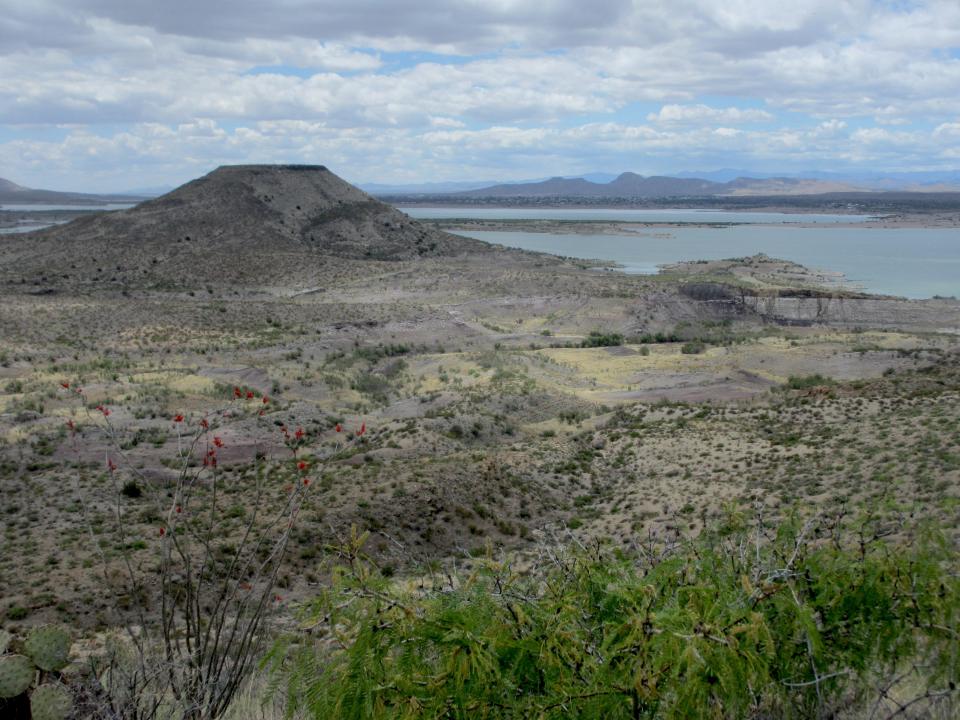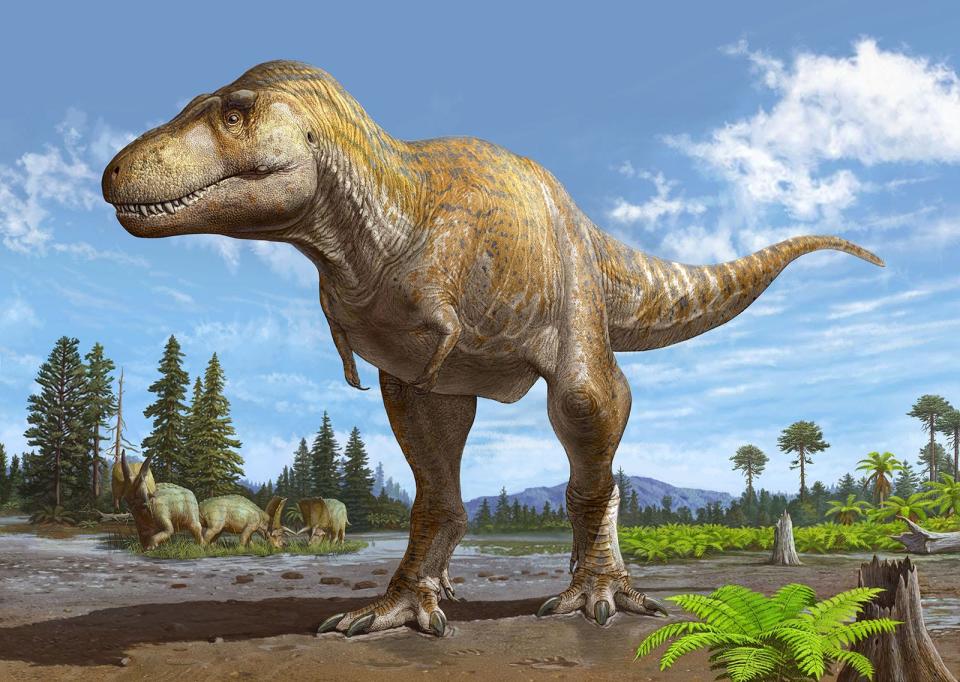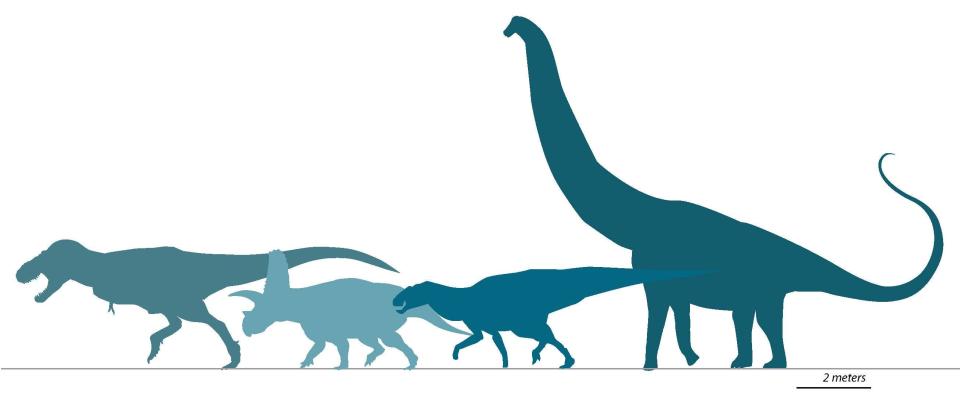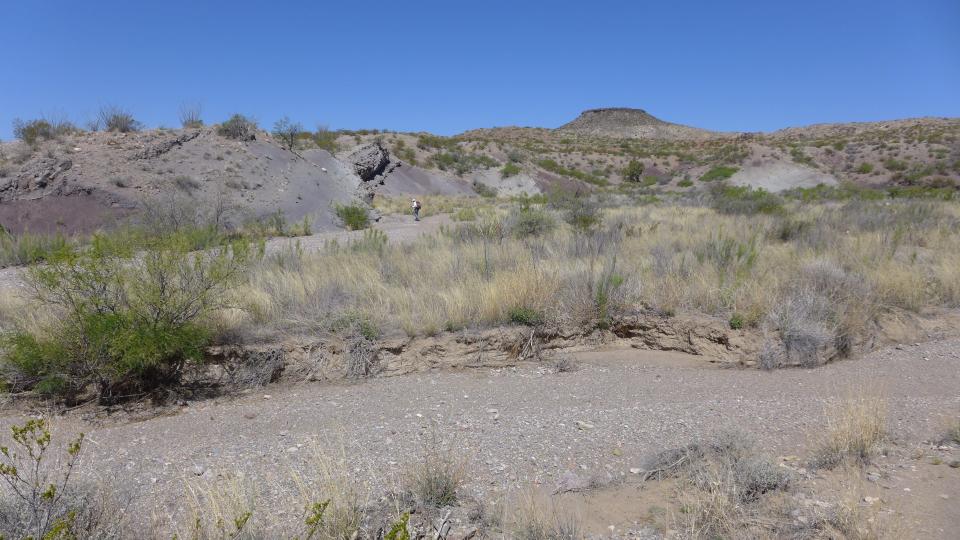A fossil found in New Mexico is reshaping what scientists know about Tyrannosaurus rex
Tyrannosaurus rex roamed the Earth up to 68 million years ago, but paleontologists for about a century had no clues as to where this massive and iconic animal came from.
That changed when a jawbone was found in New Mexico.
It was dug up by two Las Cruces residents in the 1980s on a boating trip through Elephant Butte which landed on the lake’s eastern shore.

More: Local landmark: Prehistoric Trackways National Monument offers hiking, fossils for visitors
There, they found a chunk of rock containing a page in the history of the world, and promptly turned it in to scientists for study.
The fossil was from the lower mandible of what was originally believed to be a T. rex but was given new analysis by researchers in a study starting in 2016.
That research through the lens of modern understanding unlocked renewed theories and questions indicating the bone belonged to an older relative the deadly predator.
More: Grant to support research of delicate artifacts found in Guadalupe Mountains
A report on the findings was published Thursday by the New Mexico Museum of Natural History and Science, renaming the jawbone as belonging to a new species ― Tyrannosaurus mcraeensis.

Author of the study Dr. Anthony Fiorillo, who serves as the museum’s executive director, said the finding showed the importance of New Mexico in Earth’s history.
He was joined by researchers from the University of Bath in the United Kingdom, University of Utah, The George Washington University, Harrisburg University, Penn State Lehigh Valley and the University of Alberta in Canada.
More: Aztec Ruins historic inscriptions survey yields plenty of results — and a few surprises
“New Mexicans have always known our state is special, now we know that New Mexico has been a special place for tens of millions of years,” he said. “This study delivers on the mission of this museum through the science-based investigation of the history of life on our planet.”
The findings indicated the tyrannosaur could date back further to about 72 million years ago, and placed its possible origin in North American, not Asia as previously believed, said Dr. Spencer Lucas, paleontology curator at the museum.
He said the lower jaw of the new species was “more slender and shallow,” compared to the “massive” and “thicker” jaw bone of Tyrannosaurus rex.
More: Further evidence points to footprints in New Mexico as oldest sign of humans in Americas
“The difference in the lower jaw shape indicates different feeding or a different method of feeding. That’s a big deal,” Lucas said.

Scientists also pointed to a post orbital bone behind the eye of the specimen, finding a pronounced ridge known in T. rex was not present in the older fossil.
This would have meant a drastically different appearance in Tyrannosaurus mcraeensis’ face, Lucas said.
More: Fossilized skull from Bisti identified as newly-discovered horned dinosaur species
“That visual recognition is important for mating, who to fight and not fight,” he said. “We see this now with deer and bighorn sheep. They know who are members of their own species.”
He said the discovery of a predecessor to the T. rex could change much of what is known about the animal by the scientific community.
This could unlock more about how the T. rex lived on Earth, and what led to its ultimate extinction.
“Before this study, the animal sort of fell out of the sky. It doesn’t have an ancestor,” Lucas said. “Since the 1980s we’ve learned a tremendous amount more about T. rex. More fossils have been found. We have a much greater knowledge of the anatomy of T. rex. We looked at this fossil in the light of that new knowledge.
“This is how science works. When we’ve learned a lot more, we rethink our conclusions.”
He hoped the discovery could lead to more expeditions to New Mexico, with scientists searching for more remains of the animal to increase their understanding and answer new questions posed by the study.
More: A 300-million-year-old 'Godzilla' shark discovered in New Mexico now has an official name
“We have this one fossil. We want more. We’re hoping we’ll be able to go out find more of these fossils,” he said. “One of the things many people try to do is understand the history of this planet. We want to learn the lessons of history. We don’t do a good job of that, but we still try.”

Those efforts also caught the eye of New Mexico Gov. Michelle Lujan Grisham, who said in a statement that the breakthrough was a testament to the state’s place at the “forefront” of scientific discovery.
“New Mexico’s cultural institutions continue to lead the way on groundbreaking work in their respective fields and remain a key pillar of our statewide economy,” she said.
The new dinosaur was the latest in a vast history of paleontological discoveries in New Mexico, Lucas said, in a state typified by dry conditions and exposed rock dating back millions of years.
He said the museum was planning to open an exhibit on the Paleozoic Era, about 250 million to 500 million years ago, when much of New Mexico was covered by oceans including the Permian Reef, and heavily populated with prehistoric creatures.
“Acre for acre, there’s more fossils in New Mexico than any other place. We have rocks from all of the ages of dinosaurs here,” he said. “To me, New Mexico is ground zero for dinosaur research. There’s just a lot of fossils to be found.”
Adrian Hedden can be reached at 575-628-5516, achedden@currentargus.com or @AdrianHedden on the social media platform X.
This article originally appeared on Carlsbad Current-Argus: Fossil found in New Mexico unlocks history of Tyrannosaurus rex

